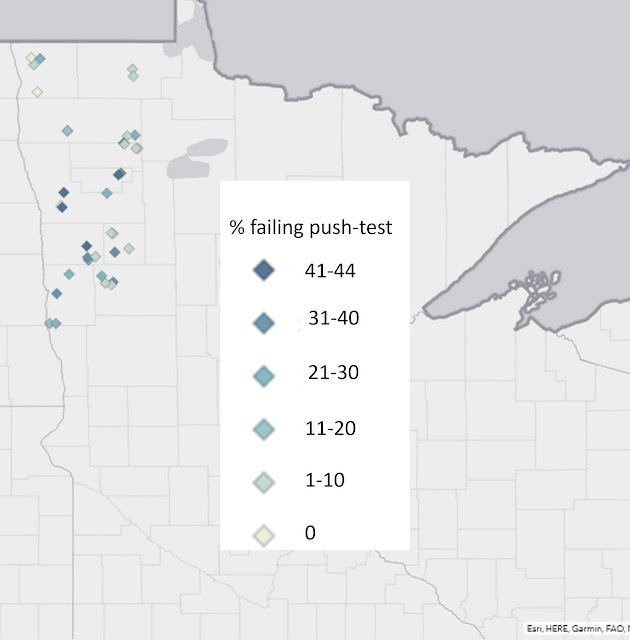One of my favorite times of the year is when I get to spend some 'quality time' in northwest Minnesota corn fields looking for European corn borer injury and checking stalk strength. Corn harvest will be delayed with the rainy weather. As you are waiting for soil to dry a bit before resuming harvest, time spent checking stalk strength will be time well spent.
Kernels demand sugars. Developing corn kernels place a very high demand on the plant for sugars. Stress reduces the rate of photosynthesis, thereby reducing the amount of sugars that the plant is able to produce. Many different stresses can reduce the rate of photosynthesis: too much or too little moisture, nutrient imbalances, plant injury (ex.: hail, insects, diseases), excessive plant populations, and even long-periods of cloudy weather. In northwest Minnesota in 2023 these stresses from May 1 through September 15 included average daily high temperatures 2 to 4 degrees warmer than normal (Figure 1), average daily low temperatures 1 to 4 degrees warmer than normal (Figure 2) and 6 to 8 inches less rain than normal (Figure 3).
 |
| Figure 1. Average daily high temperature departure from normal from May 1 through September 15, 2023. Source: Midwest Regional Climate Center. |
 | |
| Figure 2. Average daily low temperature departure from normal from May 1 through September 15, 2023. Source: Midwest Regional Climate Center. |

Figure 3. Rainfall departure from normal from May 1 through
September 15, 2023. Source: Midwest Regional Climate Center.
Stalk rots. If the plant is unable to keep up
with kernel sugar demand, the plant can rob sugars from stalk tissue,
predisposing it to stalk rotting fungi. Corn plants are top-heavy and stalk rots
increase the chances that plants will fall over (lodge) due to either
gravity or wind and other weather events.
Pinch or push test. To better understand how much stalk rot
might be present in a given field it is recommend that each field is
scouted in one of two ways, by pinching or pushing plants. Regardless
of the test, walk each field in a zig-zag pattern, checking 20 random
plants from 5 spots in the field. For the pinch test, pinch stalks
toward the base, below the lowest node, checking for firmness. For the
push test, hold your arm out from your body and push the plant to see if
the stalk bends or breaks.
With either test, there is a significant lodging potential if 10 to 15% of the plants fail your particular test.
This year, 14 of the 36 fields that I visited had fewer than 10% of plants that failed the push test (Figure 4), 16 fields had greater than 20% of plants failing the push test, 10 fields had greater than 30% of plants failing the push test and 7 fields with 40% or more plants failing the push test. All told 53% of fields surveyed had a heightened risk of lodging.
Triaging harvest. Pinch or push-testing your fields can help in
prioritizing which fields need to be harvested first to avoid having to
harvest lodged corn. Specialized reel-systems have been designed to
better salvage downed corn but as most don’t own such an implement
general harvest recommendations include: slow drive speeds and
harvesting against the grain.
 |
| Figure 4. Percentage of plants 'failing' a push test at various locations in northwest Minnesota in fall 2023. |
One thing is for certain: with different corn hybrids, soil types and environmental conditions experienced by the crop in northwest Minnesota, no generalized regional survey can stand in for surveying your own fields.
Comments
Post a Comment